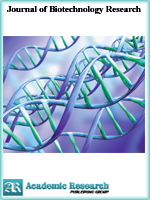Journal of Biotechnology Research
Online ISSN: 2413-3256
Print ISSN: 2413-8878
Print ISSN: 2413-8878
Quarterly Published (4 Issues Per Year)

Archives
Volume 3 Number 11 November 2017
Preliminary Study on the Antifungal and Antimicrobial Activities of Some Medicinal Plants of Turkey
Authors: ?igdem K???k ; Cenap Cevheri
Pages: 110-113
Abstract
In this study, acetone, alchol and hexane extracts Aloysia triphylla, Mentha aquatica, Foeniculum vulgare, Calendula officinalis, Salvia officinalis and Rumex acetosa used for medicinal purpose in Turkey were tested for antimicrobial activity by the diffusion method. These extracts were tested on Staphylococcus aureus NRRL-B 767, Micrococcus luteus, Bacillus subtilis NRS-744, B.cereus ATCC 11778, Escherichia coli ATCC 25922, Listeria monocytoponus ATCC 7644, Klebsiella pneumoniae, Yersinia enterocolitica, Proteus vulgaris, Enterococcus fecolis ATCC 29212, Xanthomonas phaseoli, Pseudomonas fluorescens, Fusarium oxysporum, F. culmorum, F.aveneceum, F.moniliforme, Gaeumannomycetes graminis var. tritici, Alternaria citri and Trichoderma harzianum. As conclusion, extracts of Aloysia triphylla, Mentha aquatica, Foeniculum vulgare, Calendula officinalis, Salvia officinalis and Rumex acetosa inhibited the growth of microorganisms used in these tests at different ratios. We have found that acetone extracts of tested plants relealed antimicrobial activity against bacteria but it had no antifungal activity against fungi used in this study.
Potential Antifungal Activity of Fresh Garlic Cloves (Allium sativum L.) from Sudan
Authors: Emad Mohamed Abdallah
Pages: 106-109
Abstract
The incidences of fungal infections are increasing due to the growing phenomena of antifungal resistance and a limited number of antifungal drugs. As some fungi adversely affect on human health such as Candida albicans, or on its economic plants such as Aspergillus niger. In the current study, minced cloves of garlic from the Sudanese variety was tested against two referenced fungi, namely Aspergillus niger ATCC®6275TM and Candida albicans ATCC®10231TM. The results showed that garlic has a noticeable and high antifungal activity against both fungal strains, the inhibition zones of garlic were 41.0±4.0 mm and 28.0±1.0 mm, respectively, compared with clotrimazole which was 22.5±1.5 mm and 27.5±0.5 mm, respectively. This antifungal activity was statistically significant. Though, the fresh minced cloves of garlic was a competitor to that antifungal drug. With the available data, it can be concluded that garlic bulb is a potent antifungal agent.



